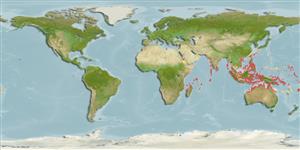>
Tetraodontiformes (Puffers and filefishes) >
Balistidae (Triggerfishes)
Etymology: Rhinecanthus: Greek, rhinos = nose + Greek, akantha = thorn (Ref. 45335).
Eponymy: Pablo Ruiz Picasso (1881–1973) was a Spanish painter and sculptor. The vivid patterns and colours of Rhinecanthus triggerfish have led to them being popularly known as picassofish. (Ref. 128868), visit book page.
More on author: Linnaeus.
Environment: milieu / climate zone / depth range / distribution range
Ecologia
marinhas associadas(os) a recifes; intervalo de profundidade 1 - 20 m (Ref. 9710). Tropical; 32°N - 21°S
Indo-West Pacific: Seychelles, Chagos Archipelago through northern Australia to Vanuatu, north to southern Japan.
Tamanho / Peso / Idade
Maturity: Lm ? range ? - ? cm
Max length : 23.0 cm TL macho/indeterminado; (Ref. 9710); common length : 19.0 cm TL macho/indeterminado; (Ref. 5450)
Espinhos dorsais (total) : 3; Raios dorsais moles (total) : 23 - 26; Espinhos anais: 0; Raios anais moles: 21 - 23.
Inhabit subtidal reef flats and protected lagoons, Ref. 48637. Found mainly in rubble-algal habitat and usually in loose aggregations. Sometimes solitary (Ref. 90102). Shy species, usually swimming away or when small, diving into holes (Ref. 48637). Oviparous (Ref. 205). Also taken by drive-in nets (Ref. 9770).
Life cycle and mating behavior
Maturidade | Reprodução | Desova | Ovos | Fecundidade | Larvas
Distinct pairing (Ref. 205).
Matsuura, K., 2001. Balistidae. Triggerfishes. p. 3911-3928. In K.E. Carpenter and V. Niem (eds.) FAO species identification guide for fishery purposes. The living marine resources of the Western Central Pacific. Vol. 6. Bony fishes part 4 (Labridae to Latimeriidae), estuarine crocodiles. FAO, Rome. (Ref. 9770)
Categoria na Lista Vermelha da IUCN (Ref. 130435: Version 2024-2)
Ameaça para o homem
Harmless
Utilização humana
Pescarias: pouco comercial; Aquário: Espécies comerciais
Ferramentas
Relatórios especiais
Descarregue XML
Fontes da internet
Estimates based on models
Preferred temperature (Ref.
123201): 26.2 - 29.3, mean 28.6 °C (based on 2192 cells).
Phylogenetic diversity index (Ref.
82804): PD
50 = 0.5078 [Uniqueness, from 0.5 = low to 2.0 = high].
Bayesian length-weight: a=0.01905 (0.01099 - 0.03305), b=2.91 (2.76 - 3.06), in cm total length, based on LWR estimates for this species & (Sub)family-body (Ref.
93245).
Nível Trófico (Ref.
69278): 3.5 ±0.3 se; based on size and trophs of closest relatives
Resiliência (Ref.
120179): Elevada, tempo mínimo de duplicação da população menor que 15 meses (Preliminary K or Fecundity.).
Fishing Vulnerability (Ref.
59153): Low vulnerability (13 of 100).
Nutrients (Ref.
124155): Calcium = 57.4 [24.4, 142.0] mg/100g; Iron = 0.671 [0.330, 1.504] mg/100g; Protein = 18.4 [16.3, 20.6] %; Omega3 = 0.112 [0.057, 0.220] g/100g; Selenium = 27.3 [14.0, 57.6] μg/100g; VitaminA = 63.1 [18.4, 222.5] μg/100g; Zinc = 1.21 [0.81, 1.79] mg/100g (wet weight);
